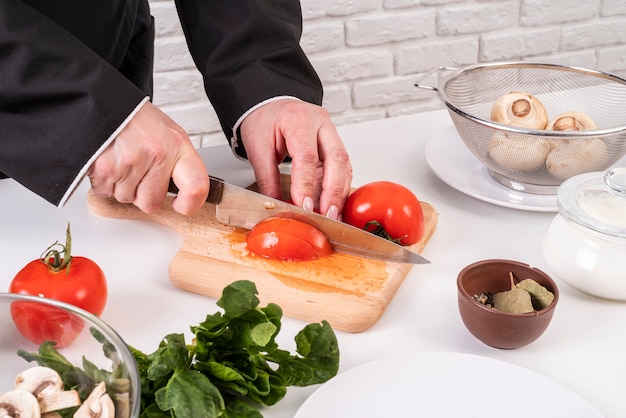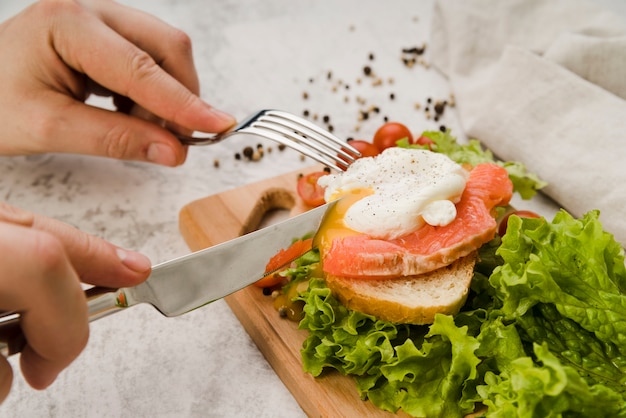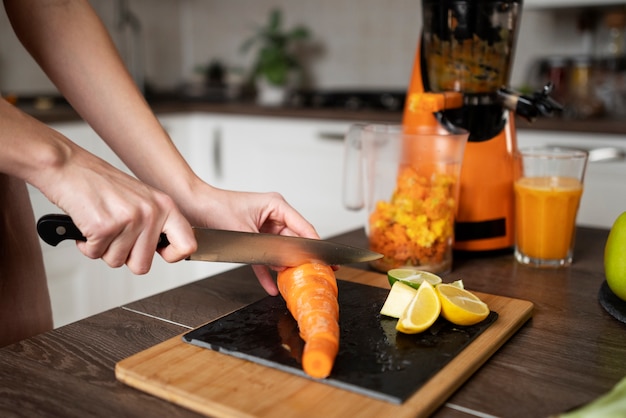Oh, salmon. It’s a culinary darling for a reason, isn't it? So versatile, so packed with flavour and goodness, and just plain delicious. But, let's be honest, sometimes cooking salmon can be a bit of a gamble. One minute you’re serving up perfectly flaky, juicy fillets, and the next, you're facing a dry, rubbery disappointment. Well, fear not, my friends! I'm here to spill all my secrets – the hard-earned wisdom I've gathered from years of cooking salmon to absolute perfection. We're talking about that heavenly, tender texture, those beautiful, even colours, and that irresistible, slightly smoky flavour. This is your ultimate guide to achieving salmon nirvana, every single time.
(Part 1) choosing the right salmon

Freshness is Everything
First and foremost, you want your salmon to be as fresh as possible. And you can tell a lot about a fish by its appearance and smell. Look for bright, clear eyes, firm flesh that springs back when you press it gently, and a pleasant, slightly salty aroma. If the flesh is dull or smells fishy, it's probably not fresh, and it's best to give it a miss.Wild or Farmed – The Great Salmon Debate
Now, there's the age-old question of wild vs. farmed salmon. Both have their own fans, and it really comes down to personal preference. wild salmon is often considered to have a more intense flavour, a bit more robust, due to its natural diet. But, it can be more expensive and might be harder to find. Farmed salmon, on the other hand, tends to be more affordable and readily available. However, it can sometimes have a slightly milder flavour. Honestly, it's all about what you're looking for. I personally love the intensity of wild salmon when I can find it, but I’ve had some truly delicious farmed salmon too. It’s all about finding what suits your taste and budget.The Perfect Cut for Your Needs
The cut of salmon you choose will also affect the cooking time and how it cooks. A thicker steak, like a center-cut piece, will take longer to cook through than a thinner fillet. I personally love a nice, thick steak; it gives you a good amount of flesh to enjoy.Skin On or Skin Off – It’s Up to You
There's no right or wrong answer here. I prefer my salmon with the skin on. I find it adds a bit of extra flavour and helps to keep the flesh moist. Plus, it makes for a crispy, delightful skin if you cook it properly. If you prefer to remove the skin, make sure you do so carefully, as you don't want to damage the delicate flesh.(Part 2) Preparing the Salmon Steak

Pat It Dry – The Key to crispy skin
First things first, pat your salmon steak dry with some kitchen paper. This removes any excess moisture that could cause steam to build up while cooking, leading to a soggy and overcooked result. This is particularly important if you want that beautiful, crispy skin.Seasoning is an Art
Now comes the fun part – seasoning. I like to keep it simple with salt and pepper. But, don't be afraid to get creative! A squeeze of lemon juice, a sprinkle of herbs, or a pinch of chilli flakes can add a whole new dimension of flavour.Marinades: A Flavorful Boost
Marinating your salmon is a fantastic way to infuse it with even more flavour. I like to marinate mine in a simple mix of olive oil, lemon juice, garlic, and fresh herbs for a few hours before cooking. But, you can also use a more complex marinade with soy sauce, honey, and ginger, or even a spicy marinade with chillies and lime juice. It really depends on your taste and the flavours you want to achieve. Just be mindful of the marination time. Too long, and the salmon can become overly salty and lose its delicate texture. A couple of hours is generally enough for a good flavour infusion without compromising the fish.(Part 3) Cooking the Salmon Steak – Different Methods for Different Tastes

Pan-Seared salmon: The Quick and Easy Classic
This is my go-to method for a reason. It's quick, easy, and produces a beautifully caramelised crust on the outside and perfectly cooked flesh on the inside.Here’s my step-by-step guide to pan-searing salmon:
- Heat a large pan over a medium-high heat. Add a drizzle of olive oil. You want it hot enough to sizzle when the salmon hits the pan.
- Carefully place the salmon skin-side down in the pan. You should hear that satisfying sizzle as the skin starts to cook. Let it cook undisturbed for about 3-5 minutes, or until the skin is nice and crispy. You’ll know it’s ready when it lifts easily from the pan.
- Reduce the heat to medium-low and cook for another 2-3 minutes, depending on the thickness of the steak. You'll be able to see the flesh changing colour, from translucent pink to opaque.
- Flip the salmon over and cook for another 2-3 minutes, or until the flesh is just opaque. You want it to be cooked through but still moist and tender.
- Remove the salmon from the pan and rest for a few minutes before serving. This allows the juices to redistribute, resulting in a more tender and flavorful steak.
baking salmon: The Hands-Off Approach
Baking salmon is a great option if you're looking for a hands-off cooking method. It's also a great way to cook several salmon steaks at once, perfect for a family meal.Here's my approach to baking salmon:
- Preheat your oven to 400°F (200°C). Make sure your oven is nice and hot.
- Line a baking sheet with parchment paper. This makes cleaning a breeze later.
- Place the salmon steaks on the baking sheet and season them with salt, pepper, and any other desired herbs or spices. Get creative!
- Bake for 12-15 minutes, depending on the thickness of the steaks, or until the flesh is cooked through. You'll want to avoid overcooking here! The internal temperature should reach 145°F (63°C).
- Let the salmon rest for a few minutes before serving. This lets the juices settle and makes for a more succulent steak.
Grilling Salmon: For a Smoky, Outdoor Flavour
Grilling salmon is a fantastic way to achieve that smoky, outdoor flavour. It's also a great option for entertaining, especially during warmer weather.Here’s my guide to grilling salmon:
- Preheat your grill to medium-high heat. You want the grates nice and hot.
- Lightly oil the grill grates to prevent sticking. This will ensure your salmon releases easily.
- Place the salmon steaks on the grill and cook for 3-4 minutes per side, or until the flesh is just opaque. Don't overcook it! Keep an eye on it.
- Remove the salmon from the grill and rest for a few minutes before serving. This helps to retain the moisture and flavour.
smoked salmon: A Culinary Indulgence
For a truly indulgent experience, smoked salmon is a real treat. This method adds a depth of flavour that's simply irresistible, perfect for a special occasion.Here's how I approach smoked salmon:
- You can find pre-smoked salmon in most supermarkets, which is a great option if you're short on time. It's already cooked, so you'll need to handle it gently. Just add it to your plate and enjoy!
- If you want to smoke your own salmon, you'll need a smoker. You can use wood chips or pellets to add a smoky flavour, giving you more control over the process. This is a bit more involved, but well worth the effort if you're up for it. Just follow the instructions for your smoker carefully, and adjust cooking times based on the thickness of your salmon. Remember, it’s best to undercook rather than overcook.
(Part 4) The Art of Checking for Doneness
Now, how do you know when your salmon is cooked perfectly? You've got to be able to tell, it's crucial to avoid that dreaded dry, rubbery texture.The Flake Test – The Classic Approach
This is the classic way to check for doneness. Gently press the flesh of the salmon with a fork. It should flake easily, separating into delicate pieces.The Colour Test – A Visual Guide
Another indicator is the colour. The flesh will turn from a translucent pink to an opaque, slightly white colour when it's cooked through.The Temperature Test – For Added Certainty
If you want to be extra sure, you can use a thermometer. The internal temperature should reach 145°F (63°C) for safe and delicious salmon.Don't Overcook! The Golden Rule
The key is to cook the salmon just until it's cooked through, but not overcooked. overcooked salmon will be dry, tough, and lack flavour. It's a fine line, but with practice, you'll master it.(Part 5) Serving Your Salmon Steak in Style
Okay, your salmon is cooked to perfection. Now, let's talk about serving it up in style.The Sauce Situation – A Finishing Touch
A simple, flavourful sauce can really elevate your salmon. I'm a fan of a creamy dill sauce, but there are endless possibilities. You can go for a lemon butter sauce, a spicy mango salsa, or even a tangy chimichurri. Let your creativity guide you!side dish Options – Complementing the Flavour
To complete your meal, choose some delicious side dishes to complement your salmon. Roasted vegetables, like asparagus, broccoli, or Brussels sprouts, are a classic choice. Or, try a simple salad with a light vinaigrette dressing. If you're feeling more adventurous, try a couscous salad with dried fruits and nuts.Garnish for Presentation – Adding a Touch of Elegance
A few finishing touches can take your dish to the next level. A sprinkle of fresh herbs, a squeeze of lemon juice, or a few slices of cherry tomato can add a pop of colour and flavour. Presentation matters!(Part 6) Tips for Perfect Salmon Every Time
Here are a few handy tips that will help you nail that perfect salmon every single time.Don't Crowd the Pan – Space is Key
When pan-frying or grilling, make sure you give your salmon enough space. Overcrowding the pan will lead to steaming rather than searing, which can result in soggy and unevenly cooked fish. Let each steak have its own space to breathe.Rest is Crucial – Letting the Juices Settle
Allow the salmon to rest for a few minutes after cooking. This gives the juices a chance to redistribute, resulting in a more tender and flavorful steak.Keep it Simple – Sometimes Less is More
Sometimes the best approach is the simplest. A good-quality salmon steak, seasoned with just salt and pepper, can be absolutely delicious. Don't overcomplicate things; let the natural flavour shine.Experiment with Flavors – Unleash Your Creativity
Don't be afraid to experiment with different seasonings, marinades, and sauces. There are endless possibilities for flavour combinations. Have fun with it and see what you like best!(Part 7) Salmon steak mistakes to Avoid
Here are a few common mistakes to avoid when cooking salmon, so you can enjoy the best possible outcome.Overcooking – The Biggest No-No
This is the biggest no-no. Overcooked salmon is dry, tough, and lacks flavour. Follow the cooking times closely and use your best judgment to ensure your salmon is cooked perfectly.Not Patting It Dry – The Moisture Problem
Excess moisture can lead to steaming rather than searing, resulting in soggy and unevenly cooked fish. Pat your salmon dry before cooking for the best results.Crowding the Pan – A Space Issue
Overcrowding the pan will lead to steaming rather than searing, resulting in a soggy and unevenly cooked fish. Give your salmon plenty of space to cook.Not Resting It – Retaining the Flavor and Moisture
Allowing your salmon to rest for a few minutes after cooking allows the juices to redistribute, resulting in a more tender and flavorful steak.Using Too High a Heat – The Burning Problem
Too high a heat can cause the outside of the salmon to burn before the inside is cooked through. Use a medium-high heat for pan-frying or grilling.(Part 8) leftover salmon Magic
You've cooked a beautiful salmon steak, but have some leftovers. Don't worry, there are plenty of ways to use them. Leftovers don't have to be a waste!Salmon Salad – Light and Delicious
Flake the leftover salmon and add it to a salad with your favourite vegetables and dressing. It's a light and delicious way to use up your leftovers.Salmon Pasta – A Hearty and Satisfying Meal
Toss the leftover salmon with pasta, a creamy sauce, and some fresh herbs. It's a quick and easy way to turn your leftover salmon into a hearty meal.Salmon Sandwiches – Perfect for Lunch or a Snack
Spread some cream cheese or mayonnaise on a roll, add some leftover salmon, and top with some fresh vegetables. It's a perfect lunch or snack.Salmon Pizza – Adding Flavor to Your Favourite Dish
Add some leftover salmon to your favourite pizza. It's a delicious way to add a protein boost to your pizza.(Part 9) Salmon Steak Nutrition
Salmon is a great source of protein, omega-3 fatty acids, and other essential nutrients. It's also low in calories and fat, making it a healthy choice.Protein Powerhouse – Building and Repairing
Salmon is a great source of protein, which is essential for building and repairing tissues.Omega-3 Benefits – Good for Heart, Brain, and Body
Salmon is rich in omega-3 fatty acids, which are good for heart health, brain function, and reducing inflammation.Vitamin D Source – Important for Bones and Immunity
Salmon is also a good source of vitamin D, which is important for bone health and immune function.Other Nutrients – A Well-Rounded Food
Salmon also contains other essential nutrients, such as potassium, selenium, and vitamin B12.(Part 10) FAQs
Here are some frequently asked questions about cooking salmon:What's the best way to cook salmon?
There are many different ways to cook salmon, each with its own advantages. Pan-frying, baking, grilling, and smoking are all great options. The best method for you depends on your preferences and the time you have available.How long should I cook salmon?
The cooking time for salmon will depend on the thickness of the steak and the cooking method you are using. A good rule of thumb is to cook a salmon steak for 3-5 minutes per side for a medium-rare finish. Use a thermometer to ensure it reaches an internal temperature of 145°F (63°C).Can I freeze salmon?
Yes, you can freeze salmon. Wrap it tightly in plastic wrap or aluminum foil and freeze for up to 3 months. Thaw it in the refrigerator overnight before cooking.What are some good side dishes for salmon?
Roasted vegetables, salads, couscous, and rice are all great side dishes for salmon. Choose sides that complement the flavour of your salmon.What should I do with leftover salmon?
There are many ways to use leftover salmon, such as making salads, pasta dishes, sandwiches, or pizzas. Get creative and don't let those delicious leftovers go to waste!And there you have it, your ultimate guide to perfectly cooked salmon steaks! I hope these tips and tricks help you achieve salmon nirvana every time you cook. Remember, it's all about choosing the right fish, prepping it properly, and cooking it with care. Happy cooking, and enjoy those delicious, flaky salmon steaks!Everyone is watching

How to Cook Frozen Lobster Tails Perfectly: A Step-by-Step Guide
RecipesLobster. Just the word conjures up images of lavish meals, special occasions, and a taste of luxury. But let's...

Pigs in a Blanket Cooking Time: How Long to Bake for Perfect Results
RecipesAh, pigs in a blanket. Just the name conjures up images of those delightful little parcels of crispy pastry en...

Pork Fillet Cooking Time: How Long to Cook It Perfectly
RecipesPork fillet, or tenderloin as it's sometimes called, is a real favourite in our house. It's so versatile, and...

The Ultimate Guide to Tender, Juicy Pulled Pork
RecipesRight, let's talk pulled pork. It's one of those dishes that just screams "comfort food," doesn't it? I mean...

The Ultimate Guide to Cooking Delicious Frankfurters
RecipesLet's face it, we all love a good frankfurter. It's a classic, simple, and always satisfying. But let's be rea...
